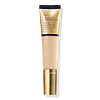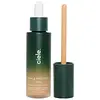Estée Lauder Futurist Hydra Rescue Moisturizing Foundation SPF 45 Versus ciele. Tint & Protect SPF 50+ Tinted Serum
What's inside
What's inside
 Key Ingredients
Key Ingredients

 Benefits
Benefits

 Concerns
Concerns

 Ingredients Side-by-side
Ingredients Side-by-side

Phenylbenzimidazole Sulfonic Acid 2.7%
UV AbsorberEthylhexyl Methoxycinnamate 6.7%
UV AbsorberEthylhexyl Salicylate 4.5%
UV AbsorberZinc Oxide 3.8%
Cosmetic ColorantWater
Skin ConditioningDimethicone
EmollientPhenyl Trimethicone
Skin ConditioningButylene Glycol
HumectantGlycerin
HumectantPolymethylsilsesquioxane
Lauryl PEG-9 Polydimethylsiloxyethyl Dimethicone
Skin ConditioningHdi/PPG/Polycaprolactone Crosspolymer
Trimethylsiloxysilicate/Dimethiconol Crosspolymer
Tromethamine
BufferingPolysilicone-11
Hexyl Laurate
EmollientCetyl PEG/PPG-10/1 Dimethicone
EmulsifyingLactobacillus Ferment
Skin ConditioningCucumis Sativus Fruit Extract
EmollientSodium Hyaluronate
HumectantSalvia Hispanica Seed Extract
EmollientHylocereus Undatus Fruit Extract
Skin ConditioningHelianthus Annuus Seedcake
AbrasiveAlgae Extract
EmollientEuterpe Oleracea Fruit Oil
Skin ConditioningCarapa Guaianensis Seed Oil
Skin ConditioningCaffeine
Skin ConditioningJojoba Esters
EmollientTremella Fuciformis Sporocarp Extract
AntioxidantCamelina Sativa Seed Oil
Skin ConditioningSapindus Mukorossi Fruit Extract
Skin ConditioningCaesalpinia Spinosa Gum
Skin ConditioningCopaifera Officinalis Resin
MaskingCaprylic/Capric Triglyceride
MaskingPropylene Glycol Dicaprate
EmollientAcetyl Glucosamine
Skin ConditioningTocopheryl Acetate
AntioxidantAcetyl Hexapeptide-8
HumectantLecithin
EmollientTrehalose
HumectantDisteardimonium Hectorite
StabilisingHydroxyethyl Urea
HumectantNeopentyl Glycol Diheptanoate
EmollientHydrogenated Coco-Glycerides
EmollientPhospholipids
Skin ConditioningTrimethylsiloxysilicate
EmollientPolyhydroxystearic Acid
EmulsifyingPolyglyceryl-4 Isostearate
EmulsifyingGlyceryl Stearate
EmollientTriethoxycaprylylsilane
Triethyl Citrate
MaskingLaureth-7
EmulsifyingLinoleic Acid
CleansingMethicone
EmollientStearyl Alcohol
EmollientCetearyl Alcohol
EmollientAmmonium Polyacryloyldimethyl Taurate
Emulsion StabilisingSilica
AbrasiveHordeum Vulgare Extract
EmollientTocopherol
AntioxidantPalmitic Acid
EmollientPhytosteryl Canola Glycerides
Skin ConditioningStearic Acid
CleansingOleic Acid
EmollientSodium Chloride
MaskingPolysorbate 80
EmulsifyingPolysorbate 20
EmulsifyingBehenyl Alcohol
EmollientTriolein
Skin ConditioningBetaine
HumectantParfum
MaskingDisodium EDTA
BHT
AntioxidantPhenoxyethanol
PreservativeSodium Dehydroacetate
PreservativePotassium Sorbate
PreservativeMica
Cosmetic ColorantCI 77491
Cosmetic ColorantCI 77492
Cosmetic ColorantCI 77499
Cosmetic ColorantCI 77891
Cosmetic ColorantPhenylbenzimidazole Sulfonic Acid 2.7%, Ethylhexyl Methoxycinnamate 6.7%, Ethylhexyl Salicylate 4.5%, Zinc Oxide 3.8%, Water, Dimethicone, Phenyl Trimethicone, Butylene Glycol, Glycerin, Polymethylsilsesquioxane, Lauryl PEG-9 Polydimethylsiloxyethyl Dimethicone, Hdi/PPG/Polycaprolactone Crosspolymer, Trimethylsiloxysilicate/Dimethiconol Crosspolymer, Tromethamine, Polysilicone-11, Hexyl Laurate, Cetyl PEG/PPG-10/1 Dimethicone, Lactobacillus Ferment, Cucumis Sativus Fruit Extract, Sodium Hyaluronate, Salvia Hispanica Seed Extract, Hylocereus Undatus Fruit Extract, Helianthus Annuus Seedcake, Algae Extract, Euterpe Oleracea Fruit Oil, Carapa Guaianensis Seed Oil, Caffeine, Jojoba Esters, Tremella Fuciformis Sporocarp Extract, Camelina Sativa Seed Oil, Sapindus Mukorossi Fruit Extract, Caesalpinia Spinosa Gum, Copaifera Officinalis Resin, Caprylic/Capric Triglyceride, Propylene Glycol Dicaprate, Acetyl Glucosamine, Tocopheryl Acetate, Acetyl Hexapeptide-8, Lecithin, Trehalose, Disteardimonium Hectorite, Hydroxyethyl Urea, Neopentyl Glycol Diheptanoate, Hydrogenated Coco-Glycerides, Phospholipids, Trimethylsiloxysilicate, Polyhydroxystearic Acid, Polyglyceryl-4 Isostearate, Glyceryl Stearate, Triethoxycaprylylsilane, Triethyl Citrate, Laureth-7, Linoleic Acid, Methicone, Stearyl Alcohol, Cetearyl Alcohol, Ammonium Polyacryloyldimethyl Taurate, Silica, Hordeum Vulgare Extract, Tocopherol, Palmitic Acid, Phytosteryl Canola Glycerides, Stearic Acid, Oleic Acid, Sodium Chloride, Polysorbate 80, Polysorbate 20, Behenyl Alcohol, Triolein, Betaine, Parfum, Disodium EDTA, BHT, Phenoxyethanol, Sodium Dehydroacetate, Potassium Sorbate, Mica, CI 77491, CI 77492, CI 77499, CI 77891
Zinc Oxide 12%
Cosmetic ColorantWater
Skin ConditioningC12-15 Alkyl Benzoate
AntimicrobialButyloctyl Salicylate
Skin ConditioningLauryl PEG-8 Dimethicone
Titanium Dioxide
Cosmetic ColorantCI 77891
Cosmetic ColorantIsododecane
EmollientPropanediol
SolventIron Oxides
CI 77492
Cosmetic ColorantDimethicone
EmollientNiacinamide
SmoothingPolymethylsilsesquioxane
Isohexadecane
EmollientTrilaureth-4 Phosphate
EmulsifyingDimethiconol
EmollientCaprylyl Methicone
Skin ConditioningMica
Cosmetic ColorantOctyldodecyl Neopentanoate
EmollientLauryl PEG-10 Tris(Trimethylsiloxy)Silylethyl Dimethicone
EmulsifyingSodium Chloride
MaskingPhenoxyethanol
PreservativeBisabolol
MaskingCI 77491
Cosmetic ColorantDisteardimonium Hectorite
StabilisingCI 77499
Cosmetic ColorantCaprylyl Glycol
EmollientAllantoin
Skin ConditioningPolyglyceryl-4 Diisostearate/Polyhydroxystearate/Sebacate
EmulsifyingAluminum Hydroxide
EmollientHydrogenated Lecithin
EmulsifyingEthylhexylglycerin
Skin ConditioningHexylene Glycol
EmulsifyingPropylene Carbonate
SolventPEG-10
HumectantZinc Oxide 12%, Water, C12-15 Alkyl Benzoate, Butyloctyl Salicylate, Lauryl PEG-8 Dimethicone, Titanium Dioxide, CI 77891, Isododecane, Propanediol, Iron Oxides, CI 77492, Dimethicone, Niacinamide, Polymethylsilsesquioxane, Isohexadecane, Trilaureth-4 Phosphate, Dimethiconol, Caprylyl Methicone, Mica, Octyldodecyl Neopentanoate, Lauryl PEG-10 Tris(Trimethylsiloxy)Silylethyl Dimethicone, Sodium Chloride, Phenoxyethanol, Bisabolol, CI 77491, Disteardimonium Hectorite, CI 77499, Caprylyl Glycol, Allantoin, Polyglyceryl-4 Diisostearate/Polyhydroxystearate/Sebacate, Aluminum Hydroxide, Hydrogenated Lecithin, Ethylhexylglycerin, Hexylene Glycol, Propylene Carbonate, PEG-10
 Reviews
Reviews

Ingredients Explained
These ingredients are found in both products.
Ingredients higher up in an ingredient list are typically present in a larger amount.
Ci 77491 is also hydrated iron III oxide. It's sole purpose is to give a red/pink hue to products.
Iron III oxides are classified as inorganic chemicals for coloring.
Synthetically created Ci 77491 is considered safer than those naturally found. This is because the synthetically created version may contain less impurities. Iron oxides are generally non-toxic and non-allergenic.
Learn more about CI 77491Ci 77492 is also hydrated iron III oxide. It's sole purpose is to give a yellow hue to products.
Iron III oxides are classified as inorganic chemicals for coloring.
Synthetically created Ci 77492 is considered safer than those naturally found. This is because the synthetically created version may contain less impurities. Iron oxides are generally non-toxic and non-allergenic.
Learn more about CI 77492Ci 77499 is also hydrated iron III oxide. It is created from mixing red and black iron oxides. This helps give shades of darkness to a product.
Iron III oxides are classified as inorganic chemicals for coloring.
Ci 77891 is a white pigment from Titanium dioxide. It is naturally found in minerals such as rutile and ilmenite.
It's main function is to add a white color to cosmetics. It can also be mixed with other colors to create different shades.
Ci 77891 is commonly found in sunscreens due to its ability to block UV rays.
Learn more about CI 77891Dimethicone is a type of synthetic silicone created from natural materials such as quartz.
What it does:
Dimethicone comes in different viscosities:
Depending on the viscosity, dimethicone has different properties.
Ingredients lists don't always show which type is used, so we recommend reaching out to the brand if you have questions about the viscosity.
This ingredient is unlikely to cause irritation because it does not get absorbed into skin. However, people with silicone allergies should be careful about using this ingredient.
Note: Dimethicone may contribute to pilling. This is because it is not oil or water soluble, so pilling may occur when layered with products. When mixed with heavy oils in a formula, the outcome is also quite greasy.
Learn more about DimethiconeDisteardimonium Hectorite comes from the clay mineral named hectorite. It is used to add thickness to a product.
It can also help stabilize a product by helping to disperse other ingredients.
Hectorite is a rare, white clay mineral.
Learn more about Disteardimonium HectoriteMica is a naturally occurring mineral used to add shimmer and color in cosmetics. It can also help improve the texture of a product or give it an opaque, white/silver color.
Serecite is the name for very fine but ragged grains of mica.
This ingredient is often coated with metal oxides like titanium dioxide. Trace amounts of heavy metals may be found in mica, but these metals are not harmful in our personal products.
Mica has been used since prehistoric times throughout the world. Ancient Egyptian, Indian, Greek, Roman, Aztec, and Chinese civilizations have used mica.
Learn more about MicaPhenoxyethanol is a preservative that has germicide, antimicrobial, and aromatic properties. Studies show that phenoxyethanol can prevent microbial growth. By itself, it has a scent that is similar to that of a rose.
It's often used in formulations along with Caprylyl Glycol to preserve the shelf life of products.
Polymethylsilsesquioxane is a silicone used as a film forming agent.
When applied to the skin, this ingredient creates an invisible film on the surface. This film still allows oxygen to pass through, but prevents moisture from escaping. This can help condition and hydrate the skin. It also leaves a silky feel when applied.
Polymethylsilsesquioxane has not been shown to clog pores. It has been deemed safe to use up to 55%, but most cosmetics use much less.
If you have concerns about using this ingredient, we recommend speaking with a professional.
Learn more about PolymethylsilsesquioxaneChances are, you eat sodium chloride every day. Sodium Chloride is also known as table salt.
This ingredient has many purposes in skincare: thickener, emulsifier, and exfoliator.
You'll most likely find this ingredient in cleansers where it is used to create a gel-like texture. As an emulsifier, it also prevents ingredients from separating.
There is much debate on whether this ingredient is comedogenic. The short answer - comedogenic ratings don't tell the whole story. Learn more about comegodenic ratings here.
The concensus about this ingredient causing acne seems to be divided. Research is needed to understand if this ingredient does cause acne.
Scrubs may use salt as the primary exfoliating ingredient.
Learn more about Sodium ChlorideWater. It's the most common cosmetic ingredient of all. You'll usually see it at the top of ingredient lists, meaning that it makes up the largest part of the product.
So why is it so popular? Water most often acts as a solvent - this means that it helps dissolve other ingredients into the formulation.
You'll also recognize water as that liquid we all need to stay alive. If you see this, drink a glass of water. Stay hydrated!
Learn more about WaterZinc Oxide is a mineral broad-spectrum UV filter; it is the broadest UVA and UVB reflector approved by the FDA. It also has skin protectant and skin soothing properties.
Zinc oxide is one of the most effective broad-spectrum UV filters. It protects against UVB, UVAII, and UVAI. In comparison to its counterpart titanium dioxide, zinc oxide provides uniform and extended UVA protection.
Another great benefit? This ingredient is highly photostable so it won't degrade easily under sunlight.
A common myth is that mineral UV filters are widely believed to primarily reflect UV light.
However, modern research shows titanium dioxide absorbs UV radiation like chemical filters (~95% absorption & 5% reflection).
Zinc oxide has great skin soothing properties so you'll likely find this in sunscreens formulated for sensitive skin or babies/children. It is unlikely to cause "eye sting" like other sunscreen ingredients.
Regulatory agencies consider zinc oxide to be non-toxic and safe. It has also been shown to not penetrate the skin.
Unfortunately, this ingredient does leave a visible white cast. This is why mineral sunscreens are often less cosmetically elegant than chemical or hybrid ones.
In cosmetics, zinc oxide can be found in both non-nano and nano-sized forms. The nano version is used to reduce white cast and improve the texture of sunscreen formulas.
There are ongoing concerns surrounding nano-zinc oxide's impact on marine ecosystems and whether it can be absorbed into skin.
Regarding marine ecosystems and coral reefs, there is no conclusive evidence that any form of zinc oxide (or any other sunscreen ingredients) will cause harm. The science is still developing but many consumers are keeping a close eye on this issue.
Please note, many destinations have reef-safety sunscreen rules. For instance, the U.S. Virgin Islands advises all visitors to use non-nano mineral sunscreens.
There has also been some stir about whether micronized or nano zinc oxide has potential photoxicity and absorption through the skin/lungs.
An in-vitro (done in a test tube or petri dish) study demonstrated micronized zinc oxide to have potential phototoxicity. There's no need to fret; the EU Commission's Scientific Committee on Consumer Safety has stated, "The relevance of these findings needs to be clarified by appropriate investigations in vivo." Or in other words, further studies done on living organisms are needed to prove this.
Current research shows zinc oxide nanoparticles do not penetrate intact or sunburned skin. They either remain on the surface or in the outermost layer of dead skin (stratum corneum).
Zinc oxide is one of only two classified mineral UV filters with titanium dioxide being the other one.
Fun fact: Zinc has been used throughout history as an ingredient in paint and medicine. An Indian text from 500BC is believed to list zinc oxide as a salve for open wound. The Ancient Greek physician Dioscorides has also mentioned the use of zinc as an ointment in 1AD.
Learn more about Zinc Oxide